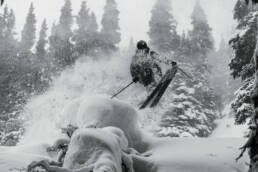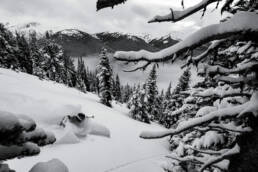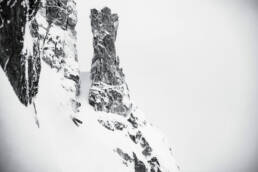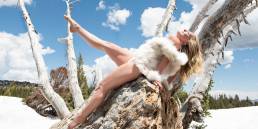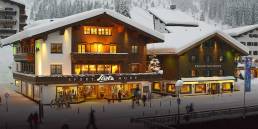For visitors to Whistler Blackcomb, North America’s largest resort comes with one very big bonus: room to explore.
Ski areas might be the only place in the world where explosions are an acceptable alarm clock. Indeed, the percussive reverberations of avalanche-control bombs draw skiers up from the valley like a siren call to the peaks. With its vast alpine acreage to manage, British Columbia’s Whistler Blackcomb may offer a more relentless alarm than most on a snow day, but it only reflects the greater rewards of heeding its call.
One day last winter I’d answered that summons, heading out in the dark to join a growing lift-line for the first ride up. With snow falling at two inches an hour and over one foot on the ground already, snow was plentiful and the skiing great. With a continuing rumble of muted blasts signaling that the alpine wouldn’t open for a while, I poked around in the mid-mountain whiteout, looking for something I didn’t yet know but was sure I would find. And then, after a few zigs and zags through the trees, I popped out alone onto a sharp ridge and there it was — an open, drifted-in shot hemmed by snow ghosts that dropped from the storm-swept spine into a welcoming glade of old-growth forest.
At that point, I didn’t know precisely where I was; but how I could live and ski in a place for twenty years and never see this line? This was going to be good.
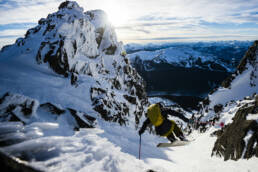
And it was good. A hundred turns of fat, light flakes streaming up over my shoulders. At the bottom, mesmerized by my discovery, questions crowded my brain. Could I actually have been here before but perhaps it looked — as much of the resort does through its annual inundation with 40 feet of snow — completely different? Or maybe it was just the vertigo-inducing whiteout of another massive Pacific storm that had rendered it unfamiliar.
While I wasn’t worried about finding my way back to a lift — all in-bounds ridges and bowls at Whistler Blackcomb funnel back to humanity-gathering cat-roads — what I did want to figure out was how I might return to this very spot; if no one else bumbled upon it before I returned, I could sign my name to another knee-deep run. And I knew that in a storm like this, in a place this big, there was a good chance no one else would find it.
Size Matters
For adventurous North American skiers, Whistler Blackcomb proves one thing their European counterparts already know: size matters. More than any other single reason, this is why the perennially top-rated resort racks up more than two million skier-visits annually. It’s also why I live here: room to lose myself, every day, without being lost at all. While either of the resort’s two mountains can deliver on this promise alone, together they offer a vacation’s, a season’s, even a lifetime’s worth of options and adventure. As Captain Kirk famously opined in the opening sequence of the original Star Trek television series: “Space — the final frontier.”
Granted, size isn’t the only consideration. On a vertical landscape, space also delivers diversity, opportunity, and, as I found out that day, surprise. Like many Whistler denizens, I was first enticed to this colossus of the Coast Mountains by the cumulative seduction of photos, movies, magazine stories, and lift-line conversations. And when I finally did visit, the facts on the ground spoke for themselves: two enormous mountains, 37 lifts, a dozen on-mountain restaurants, 13 alpine bowls, three glaciers, 5,280 feet of vertical, and over 8,171 acres of ridges, trees, bumps, steeps, chutes, cruisers, and anything else you could think of to fill a curious snowslider’s soul. Not to mention the always-open boundaries — a world of ski-touring amidst blue-toothed glaciers and untouched alpine.
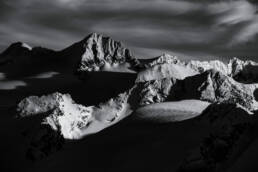
There was also the draw of wilderness, so oceanic as to render the resort an island within. Riding the lifts here I’ve watched mama bears just out of hibernation standing erect with a nose to the wind, newborn cubs rolling playfully at their feet. I’ve seen mountain lions and bobcats trot across the pistes, and bald eagles soar in from the Pacific for a look-round. From the summits of these peaks, where Whistler Village is reduced to the size of a thumbnail, it can seem as if it weren’t there at all.
For overseas visitors attuned to the call of the wild, that fact alone is a potent draw — and the reason the village presents as a bustling Tower of Babel awash in the lilts, twangs, and gutturals of a dozen languages. This same ethnic vibrancy is behind a multicultural heritage that makes Whistler the most international and cosmopolitan of any North American resort — another point of appeal that’s reflected, among other ways, in the culinary diversity of over 200 dining and drinking establishments, many of them cutting edge and tops in their class, whether they be purveyors of regional-signature Pacific Northwest fusion, landed-immigrant sushi 2.0, or globally celebrated microbrews. Couple this with the numerous other distractions of winter play — heli- and cat-skiing, cross-country skiing, snowshoeing, skating, ice-climbing, zip-lining, dog-sledding, bungy-jumping, tubing, and even bobsledding on an Olympic course — then add the significant cultural offerings like the Audain Art Museum, the Squamish Lil’wat Cultural Centre, a daily festival’s worth of live music, and a surfeit of film, photography, arts, and snowsports events that culminate every spring (at least pre-COVID) in the legendary World Ski & Snowboard Festival, and you have the stimulus and variety of a big-city metropolis condensed into a small-town package.
Although it remains a town of but 12,000 souls, it’s also a community whose vibrant mix of art, culture and outdoor enthusiasm has always welcomed and embraced tourism. In cultivating a life apart from the snowsports industry that keeps the town afloat, however, it has also created something more meaningful to share with visitors — character. And if you scan the five terrain parks, tube park, skatepark, pool complex, and pump track, you’ll see that there’s no age limit on participation. Young or old, living here or visiting, one thing was clear to me from the start: in Whistler, exploring was just what you did. Whether physically or culturally, you went to the edge — and stayed there.
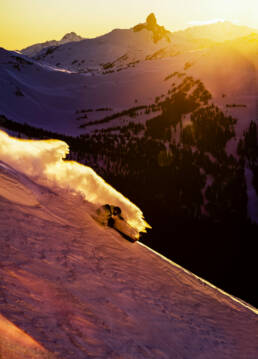
That edge is obvious in the town’s many history-making residents: the balls-to-the-wall style pioneered by the “Crazy Canucks” on the Dave Murray Downhill course, leading to a hometown World Cup win by Rob Boyd in 1989; the groundbreaking first descents in the Coast Range by Eric Pehota and Trevor Petersen in the early 1990s; the work of filmmaker Greg Stump over the decade he lived here; ski-photo titans like Paul Morrison, Eric Berger, and Blake Jorgenson; the invention of the twin-tip ski and subsequent park-and-pipe revolution sparked during the Horstman Glacier’s summer freeride camps by Mike Douglas and the New Canadian Airforce; a long list of big-mountain freeride heroes who’ve won the World Freeride Tour or become film staples; ditto the ranks of Olympian and FIS World Cup ski-cross medalists like Aleisha Cline, Ashleigh McIvor, Marielle Thompson, and Kelsey Serwa; the slopestyle heavyweights that start with Sarah Burke and end in a litany too long to print. And though I’m not as well versed in it, the snowboard ledger here may be even heavier.
History Matters
None of this could have been predicted in 1914 when, after a lengthy boat and rail trip from Vancouver, Alex and Myrtle Philip arrived in the valley to open a fishing operation. Their upstart Rainbow Lodge would flourish for decades and turn the town of Alta Lake (Whistler’s original name) into a summer tourist destination. Skiing the largely inaccessible mountains was but a glint in the eye of a select few adventurers until 1960, when the Garibaldi Lift Company formed with the intention of building a ski area to bid on the 1964 Winter Olympics. Although its bid was ultimately unsuccessful, Garibaldi’s new ski hill, Whistler — named for the piercing calls of the alpine hoary marmot — opened in 1966. Despite a perilous, slide-prone dirt road that took five hours to drive from Vancouver (now reduced by a modern highway to a smooth ninety minutes), Whistler soon became a hit. With the newly minted Resort Municipality of Whistler coordinating development, phase one of today’s main village was completed in time for the opening of neighboring Blackcomb Mountain in 1980. The two mountains were originally separate enterprises, but in 1986, Vancouver-based resort-development company Intrawest purchased Blackcomb, then added Whistler a decade later to create the slick, dual-mountain behemoth that today flies under the banner of Vail Resorts. When the five-ring circus of the Winter Olympic Games finally did hit town in 2010, these twin peaks added a full-circle Olympic story and several high-profile legacies that have only expanded the town’s function and appeal.
During my own two decades here, Whistler’s transformation has included the addition of a small country’s worth of accommodation and real estate, and much upgrading and expansion of terrain and ski operations, including the world-renowned Peak 2 Peak Gondola, a 2.73-mile engineering marvel linking the two mountains at a maximum height of 1,427 feet above the Fitzsimmons Valley — akin to taking a helicopter ride while still attached to the ground.
Of course, gewgaws like this are the kind of thing ski magazines point to while annually singing Whistler’s praises. Like these words from a 1996 resort guide: “Given the hyperbolic publicity it receives, there’s a danger Whistler Blackcomb could become the most overrated ski resort on the planet. The truth, however, is that the size of these mountains, the access to glaciers and high alpine, the sheer scope and diversity of terrain, and the spectacular setting, combine to make it an untouchable experience.”
Like many glowing reports rendered by ski writers who need to make a buck, I wasn’t entirely convinced when I wrote it — though after only a few visits I acquired some surety. Today, as a local, I look back on those words as understatement: even the hype didn’t live up to the reality.
The world-renowned Peak 2 Peak Gondola, akin to taking a helicopter ride while still attached to the ground.
Snow Matters
Of course, it all starts with snow. Packing moisture from Hawaii and Arctic air from the Gulf of Alaska, winter storms cycle in from the North Pacific to engulf Whistler Blackcomb. Brooding and powerful, they are tempests girded for battle — fighting to find a way up, over and through the labyrinthine Coast Mountains. Frustrated at the rocky barrier, the clouds release a tantrum of snow at the first opportunity. Only 25 miles from the coast, snowfall is frequent enough in Whistler that most visitors who spend more than a couple of days discover why a powder day here, with its elbowroom and diversity of terrain, is an experience within an experience.
Sure, like any big ski area there’s a ton of powderhounds and huge competition for the goods, but employing a common-sense strategy goes a long way toward maximizing your enjoyment on a powder day, and it wouldn’t be right of me not to offer a few insider tips. First, get to the lifts early. Even if you can still hear bombs going off and the alpine won’t be opening for a while, the lower- and mid-mountains — featuring an amount of terrain equivalent to several regular-sized ski areas — are always good to go. If it’s still snowing, your first move while you’re uploading should be to check the wind direction, because areas in the lee of the wind will always be 30-50 percent deeper. Next, look at the grooming report; there’s no better way to warm up — and few as outright fun — as 3,000-vertical-feet of groomer covered in fresh snow. The comfort of a predictable base allows you to establish your snow-slashing rhythm, and there will always be enough of the resort’s 200-some runs open to keep you occupied until the alpine lifts start cranking.
As for the eternal question of Which mountain?, there’s an argument to be made for starting your day on Blackcomb: more mid-mountain options, generally fewer people, and an alpine that tends to open far ahead of Whistler’s. In part, the latter is due to geology: Whistler’s terrain is more complex, with trickier pockets, cornices, and bowls that require more bombing to open safely; Whistler is also larger in acreage — with a greater share of treeless alpine. But this operational wrinkle can be a bonus: skiers can enjoy all that Blackcomb has to offer and then, when the Whistler alpine opens, move over to fresh horizons via the Peak 2 Peak Gondola, which represents not only an acme of lift engineering, but possibly the most brilliant powder-day convenience known to mankind — next to an avi-bomb alarm clock.
Related Posts
December 11, 2019
Fast Forward-Lindsey Vonn Article & Photoshoot
What Lindsey Vonn has been up to since…


